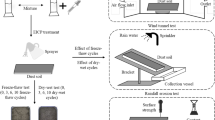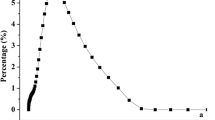Abstract
To resolve the environmental and sustainability issues from fugitive dust emission and conventional mitigation methods, multiple experiments were conducted to evaluate the suppression of fugitive dust and its effect on near-surface soil stabilization by enzyme-induced carbonate precipitation (EICP). The optimal recipes for maximum CaCO3 precipitation with high- and low-purity chemicals were first identified for the EICP treatment. Soil specimens treated with both solutions were characterized by measuring shear wave velocity and cone tip resistance. A wind tunnel test was conducted to examine how the near-surface treatment suppressed particulate matter (PM 2.5 and PM 10) against wind and dynamic impacts. The results showed that both the shear wave velocity and the peak cone tip resistance increased almost linearly with increasing solution volume up to 7 L/m2. Dust emission was effectively mitigated by increasing solution volume up to 3 L/m2. Both high- and low-purity chemicals showed a similar ability to suppress fugitive dust. Upon vibration, the treatment effect vanished, but treatment with 7 L/m2 solution made the soil remain intact. Scanning electron microscopic imaging confirmed the precipitation of vaterite when low-purity chemicals were used.










Similar content being viewed by others
References
Aïssa B, Isaifan RJ, Madhavan VE, Abdallah AA (2016) Structural and physical properties of the dust particles in Qatar and their influence on the PV panel performance. Sci Rep 6:1–12. https://doi.org/10.1038/srep31467
Amato F, Pandolfi M, Viana M et al (2009) Spatial and chemical patterns of PM10 in road dust deposited in urban environment. Atmos Environ 43:1650–1659. https://doi.org/10.1016/j.atmosenv.2008.12.009
Behrooz RD, Esmaili-Sari A, Bahramifar N, Kaskaoutis DG (2017) Analysis of the TSP, PM10 concentrations and water-soluble ionic species in airborne samples over Sistan, Iran during the summer dusty period. Atmos Pollut Res 8:403–417. https://doi.org/10.1016/j.apr.2016.11.001
Blakeley RL, Webb EC, Zerner B (1969) Jack Bean Urease (EC 3.5.1.5). A new purification and reliable rate assay. Biochemistry 8:1984–1990. https://doi.org/10.1021/bi00833a031
Carmona JPSF, Venda Oliveira PJ, Lemos LJL, Pedro AMG (2017) Improvement of a sandy soil by enzymatic calcium carbonate precipitation. Proc Inst Civ Eng Geotech Eng 171:3–15. https://doi.org/10.1680/jgeen.16.00138
Cesareo SD, Langton SR (1992) Kinetic properties of Helicobacter pylori urease compared with jack bean urease. FEMS Microbiol Lett 99:15–21. https://doi.org/10.1111/j.1574-6968.1992.tb05535.x
Chu J, Ivanov V, Naeimi M et al (2014) Optimization of calcium-based bioclogging and biocementation of sand. Acta Geotech 9:277–285. https://doi.org/10.1007/s11440-013-0278-8
Cohen AJ, Anderson HR, Ostro B et al (2005) The global burden of disease due to outdoor air pollution. J Toxicol Environ Heal Part A 68:1301–1307. https://doi.org/10.1080/15287390590936166
Cui MJ, Zheng JJ, Zhang RJ et al (2017) Influence of cementation level on the strength behaviour of bio-cemented sand. Acta Geotech 12:971–986. https://doi.org/10.1007/s11440-017-0574-9
Das N, Kayastha AM, Srivastava PK (2002) Purification and characterization of urease from dehusked pigeonpea (Cajanus cajan L.) seeds. Phytochemistry 61:513–521. https://doi.org/10.1016/S0031-9422(02)00270-4
Farmer AM (1993) The effects of dust on vegetation: a review. Environ Pollut 79:63–75
Frankenberger WT, Tabatabai MA (1982) Amidase and urease activities in plants. Plant Soil 64:153–166. https://doi.org/10.1007/BF02184247
Gambatese JA, James DE (2001) Dust suppression using truck-mounted water spray system. J Constr Eng Manag 127:53–59. https://doi.org/10.1061/(asce)0733-9364(2001)127:1(53)
Gautam R, Hsu NC, Lau KM (2010) Premonsoon aerosol characterization and radiative effects over the Indo-Gangetic plains: implications for regional climate warming. J Geophys Res Atmos 115:1–15. https://doi.org/10.1029/2010JD013819
Gavett SH, Haykal-Coates N, Copeland LB et al (2003) Metal composition of ambient PM2.5influences severity of allergic airways disease in mice. Environ Health Perspect 111:1471–1477. https://doi.org/10.1289/ehp.6300
Goudie A, Middleton NJ (2006) Desert dust in the global system and summarises recent, vol 49. Springer, Berlin, p 6221
Gu A, Teng F, Lv Z (2016) Exploring the nexus between water saving and energy conservation: insights from industry sector during the 12th Five-Year Plan period in China. Renew Sustain Energy Rev 59:28–38. https://doi.org/10.1016/j.rser.2015.12.285
Guo P, Wang J, Li X et al (2000) Combination of Micro-PIXE with the pattern recognition technique for the source identification of individual aerosol particles. Appl Spectrosc 54:807–811. https://doi.org/10.1366/0003702001950427
Hamdan N, Kavazanjian E (2016) Enzyme-induced carbonate mineral precipitation for fugitive dust control. Géotechnique 66:546–555. https://doi.org/10.1680/jgeot.15.p.168
Hilker T, Natsagdorj E, Waring RH et al (2014) Satellite observed widespread decline in Mongolian grasslands largely due to overgrazing. Glob Change Biol 20:418–428. https://doi.org/10.1111/gcb.12365
Krzyzanowski M, Apte JS, Bonjour SP et al (2014) Air pollution in the mega-cities. Curr Environ Heal Rep 1:185–191. https://doi.org/10.1007/s40572-014-0019-7
Lee J-S, Santamarina JC (2005) Bender elements: performance and signal interpretation. J Geotech Geoenviron Eng 131:1063–1070. https://doi.org/10.1061/(asce)1090-0241(2005)131:9(1063)
Lee W, Shin D, Yoon H, Lee J (2009) Micro-cone penetrometer for more concise subsurface layer detection. Geotech Test J 32:1–7
Li X, Zhu Y, Zhang Z (2010) An LCA-based environmental impact assessment model for construction processes. Build Environ 45:766–775. https://doi.org/10.1016/j.buildenv.2009.08.010
Mahawish A, Bouazza A, Gates WP (2018) Effect of particle size distribution on the bio-cementation of coarse aggregates. Acta Geotech 13:1019–1025. https://doi.org/10.1007/s11440-017-0604-7
Maleki M, Ebrahimi S, Asadzadeh F, Emami Tabrizi M (2016) Performance of microbial-induced carbonate precipitation on wind erosion control of sandy soil. Int J Environ Sci Technol 13:937–944. https://doi.org/10.1007/s13762-015-0921-z
Mamiya G, Takishima K, Masakuni M et al (1987) Complete amino acid sequence of jack bean urease. J Protein Chem 6:55–59. https://doi.org/10.1007/BF00248827
McTainsh G, Chan YC, McGowan H et al (2005) The 23rd October 2002 dust storm in eastern Australia: characteristics and meteorological conditions. Atmos Environ 39:1227–1236. https://doi.org/10.1016/j.atmosenv.2004.10.016
Meyer FD, Bang S, Min S et al (2011) Microbiologically-induced soil stabilization: application of Sporosarcina pasteurii for fugitive dust control. Geo-Frontiers 41165:4002–4011. https://doi.org/10.1061/41165(397)409
Middleton N (2018) Rangeland management and climate hazards in drylands: dust storms, desertification and the overgrazing debate. Nat Hazards 92:57–70. https://doi.org/10.1007/s11069-016-2592-6
Naeimi M, Chu J (2017) Comparison of conventional and bio-treated methods as dust suppressants. Environ Sci Pollut Res 24:23341–23350. https://doi.org/10.1007/s11356-017-9889-1
Neupane D, Yasuhara H, Kinoshita N, Unno T (2013) Applicability of enzymatic calcium carbonate precipitation as a soil-strengthening technique. J Geotech Geoenviron Eng 139:2201–2211. https://doi.org/10.1061/(ASCE)GT.1943-5606.0000959
Regdel D, Dugarzhav C, Gunin PD (2012) Ecological demands on socioeconomic development of Mongolia under climate aridization. Arid Ecosyst 2:1–10. https://doi.org/10.1134/s2079096112010076
Smolders E, Degryse F (2002) Fate and effect of zinc from tire debris in soil. Environ Sci Technol 36:3706–3710. https://doi.org/10.1021/es025567p
Sondi I, Matijević E (2001) Homogeneous precipitation of calcium carbonates by enzyme catalyzed reaction. J Colloid Interface Sci 238:208–214. https://doi.org/10.1006/jcis.2001.7516
Stefanski R, Sivakumar MVK (2009) Impacts of sand and dust storms on agriculture and potential agricultural applications of a SDSWS. IOP Conf Ser Earth Environ Sci 7:012016. https://doi.org/10.1088/1755-1307/7/1/012016
United States Environmental Protection Agency (1996) AP-42: compilation of air emissions factors. AP 42, 5th edn. Compil Air Pollut Emiss Factors, vol 1 Station. Point Area Sources 44
Vaezi AR, Ahmadi M, Cerdà A (2017) Contribution of raindrop impact to the change of soil physical properties and water erosion under semi-arid rainfalls. Sci Total Environ 583:382–392. https://doi.org/10.1016/j.scitotenv.2017.01.078
Wang X, Kong R, Pan X et al (2009) Role of ovalbumin in the stabilization of metastable vaterite in calcium carbonate biomineralization. J Phys Chem B 113:8975–8982. https://doi.org/10.1021/jp810281f
Wang Z, Zhang N, Ding J et al (2018) Experimental study on wind erosion resistance and strength of sands treated with microbial-induced calcium carbonate precipitation. Adv Mater Sci Eng. https://doi.org/10.1155/2018/3463298
Weber M, Jones MJ, Ulrich J (2008) Optimisation of isolation and purification of the jack bean enzyme urease by extraction and subsequent crystallization. Food Bioprod Process 86:43–52. https://doi.org/10.1016/j.fbp.2007.10.005
WHO (2005) WHO Air quality guidelines for particulate matter, ozone, nitrogen dioxide and sulfur dioxide: Global update 2005. Glob. Updat. 2005, pp 1–21
Wu Z, Zhang X, Wu M (2016) Mitigating construction dust pollution: state of the art and the way forward. J Clean Prod 112:1658–1666. https://doi.org/10.1016/j.jclepro.2015.01.015
Xing J, Ye K, Zuo J, Jiang W (2018) Control dust pollution on construction sites: what governments do in China? Sustainability 10:2945. https://doi.org/10.3390/su10082945
Xu L, Pei Z (2017) Preparation and optimization of a novel dust suppressant for construction sites. J Mater Civ Eng 29:04017051. https://doi.org/10.1061/(asce)mt.1943-5533.0001902
Zhao HL, Zhao XY, Zhou RL et al (2005) Desertification processes due to heavy grazing in sandy rangeland, Inner Mongolia. J Arid Environ 62:309–319. https://doi.org/10.1016/j.jaridenv.2004.11.009
Zhao X-Y, Cheng S-Y, Tian G et al (2007) Construction fugitive dust pollution and control in Beijing. J Beijing Univ Technol 33:1086–1090
Zheng S, Pozzer A, Cao CX, Lelieveld J (2015) Long-term (2001–2012) concentrations of fine particulate matter (PM2.5) and the impact on human health in Beijing, China. Atmos Chem Phys 15:5715–5725. https://doi.org/10.5194/acp-15-5715-2015
Zuo J, Rameezdeen R, Hagger M et al (2017) Dust pollution control on construction sites: awareness and self-responsibility of managers. J Clean Prod 166:312–320. https://doi.org/10.1016/j.jclepro.2017.08.027
Acknowledgements
This work was supported by the Land and Housing Institute (LHI) grant funded by the Korea Land and Housing Corporation, the National Research Foundation of Korea (NRF) grant funded by the Korea government (MSIT) (2016R1A2B4011292), and the research fund of the Korea Agency for Infrastructure Technology Advancement (KAIA) (19CTAP-C142849-02).
Author information
Authors and Affiliations
Corresponding author
Additional information
Publisher's Note
Springer Nature remains neutral with regard to jurisdictional claims in published maps and institutional affiliations.
Rights and permissions
About this article
Cite this article
Song, J.Y., Sim, Y., Jang, J. et al. Near-surface soil stabilization by enzyme-induced carbonate precipitation for fugitive dust suppression. Acta Geotech. 15, 1967–1980 (2020). https://doi.org/10.1007/s11440-019-00881-z
Received:
Accepted:
Published:
Issue Date:
DOI: https://doi.org/10.1007/s11440-019-00881-z




